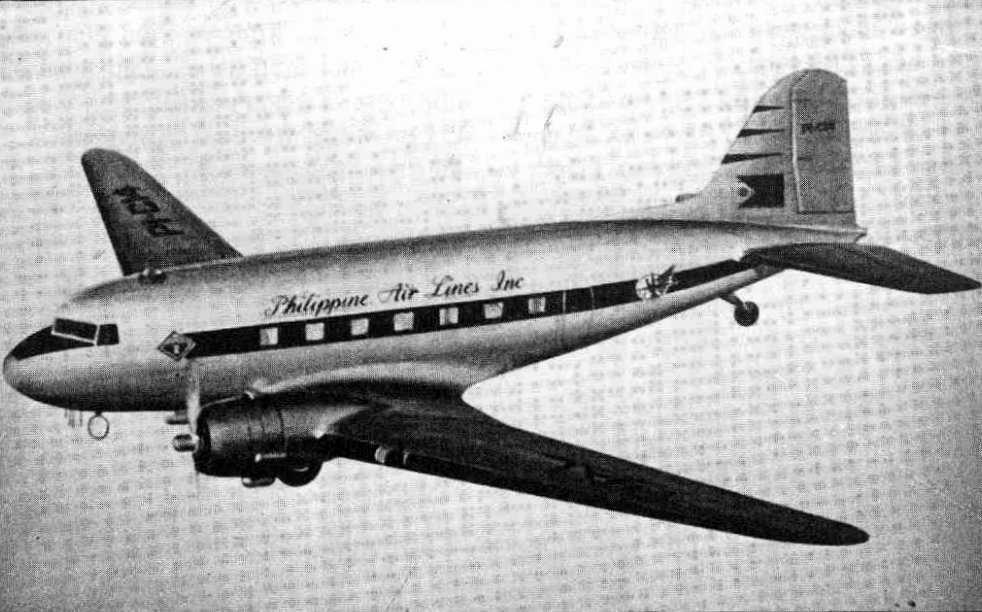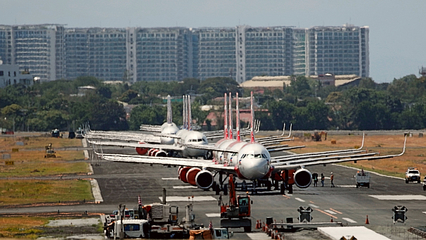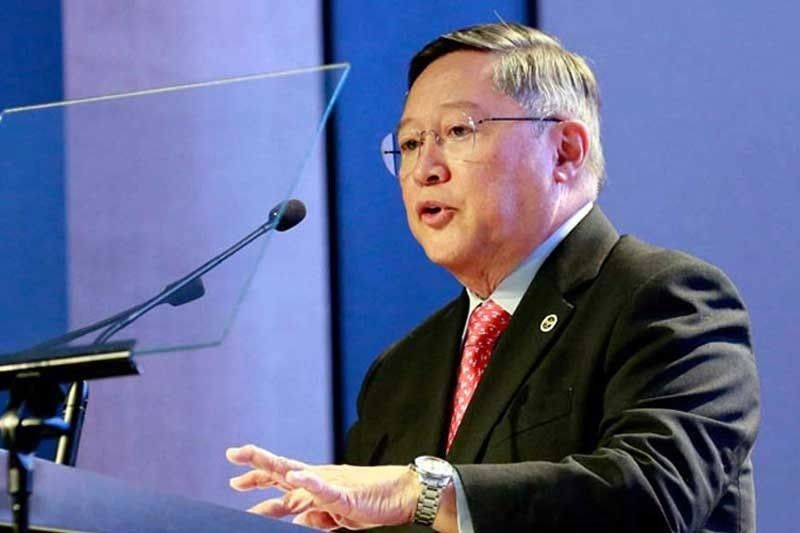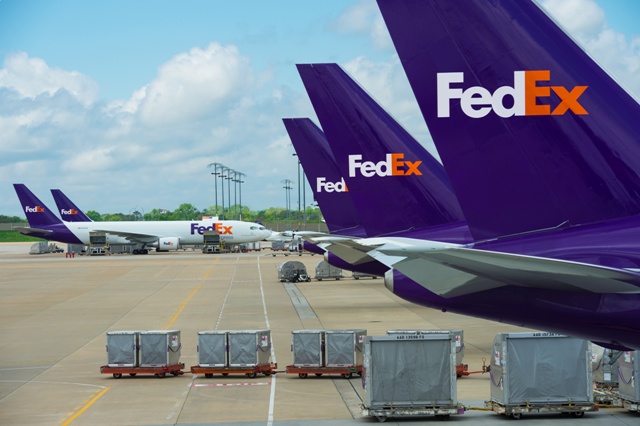 |
| Philippine Air Asia flew its inaugural flight to Zamboanga City yesterday. Due to Covid19 quarantine restrictions, airlines are allowed only to mount commercial flights every Tuesday and Thursday. |
February 11, 1911 - February 11, 2011. First Red Devil biplane was flown in Manila with James C. Mars as its first pilot.
AirAsia Inaugural Flight to Zamboanga
CEB Dissolves JV with SIAE
Covid19 Fallout
27 October 2020
Low cost carrier Cebu Pacific (CEB) and Singapore based-SIA Engineering (SIAEC) is dissolving their partnership in the Philippines.
CEB has bought out its partner Singapore's SIA Engineering Company Ltd, both from Aviation Partnership Philippines Corporation (APPC), and SIA Engineering Philippines Corporation (SIAEP).
SIA Engineering holds 51% share in APPC while CEB holds 49%. Meanwhile, SIAEC owns 65% of SIAEP while CEB owns 35%.
APPC is CEB line maintenance provider for its Airbus and ATR fleets in Manila, Cebu, Davao and Clark while SIAEP is based in Clark providing airframe maintenance, repair, de-lease checks, cabin retrofits and overhaul services for Boeing 737s, Airbus A320 and A330 aircraft, as well as line maintenance at Clark.
The airline said the acquisition cost of APPC pegged at $5.61 million cash to dissolve the joint venture, is to "closely align its line maintenance operations and strategic objectives with its network and service requirements".
At the same time, SIAEC is acquiring CEB’s 35% stake in SIAEP for $7.74 million cash and states that this will be accounted for as an equity transaction.
El Al Flies Repatriation Flight
Clark Terminal 2 Completed
13 October 2020
CAAP Waives Fees For Domestic Airlines
13 October 2020
The Civil Aviation Authority of the Philippines (CAAP) disclosed Monday that it will waive airport fees for domestic air carriers in compliance with the Bayanihan to Recover as One Act (Bayanihan II) from March 16 until Dec. 19, 2020.
The regulator said it will waive aeronautical fees, landing and take-off fees, as well as airport parking fees to be paid by the domestic carriers in different airports across the country, within the coverage or effectivity of the Bayanihan II.
MIAA General Manager Ed Monreal earlier said local airlines operating in Manila alone will save P37-million a month in terms of waived take-off, landing, and parking fees.
CAAP also stated that after December 19 “The airlines will likely pay the deferred charges until after the COVID-19 threat in the country is lifted.”
Philippine Aircraft Markings, A History
Believe it or not, it all started with wireless telegraphy called "telegrams." Not the cloud-based instant messaging, video-telephony and voice over IP service app you find in your smart phone, but the telegraph message that was directly delivered to the recipient by a messenger transmitted through telegraph codes either through Baudot or Morse codes.
For the millennial, It was like the Instant Messenger app on twitter with limited number of characters about 10-15 words or less than 100 characters. The reason why characters were fewer than a hundred was because of their expensive cost of transmission. In the 90's, the cost hovers around P5.00 per character.
And since telegraph was faster than mail, telegraphic stations across the world grew by leaps and bound that it had become unmanageable by some countries due to overlapping of frequency arising from limited radio spectrum. There were also problems associated with interconnection to neighboring countries.
As the development of the telegraph in the early 19th century changed the way people communicated on the local and international levels, like what the smartphones did today, there was need for standardize regulations of radio transmission.
Between 1849 and 1865, a series of bilateral and regional agreements among Western European states attempted to standardize international communications.
Nationality Letter Marks
 To manage the radio spectrum, the International Telegraph Union (ITU) was established in 1865 to promote shared use of radio frequency by 24 (now 20) countries. The ITU then established international callsigns from participating countries to distinguish operators by their country of origin. The convention was largely European in character and influence.
To manage the radio spectrum, the International Telegraph Union (ITU) was established in 1865 to promote shared use of radio frequency by 24 (now 20) countries. The ITU then established international callsigns from participating countries to distinguish operators by their country of origin. The convention was largely European in character and influence.ITU assigned the following alphabetical prefix letters to participants mostly beginning with the first letter of each country to identify the source of transmission.
This is where Germany got the letter "D" for Deutchland, "E"for Spain (Espana), "F" for France, "G" for Great Britain, "I" for Italy, and "R"for Russia.
In 1906, The United States (US) together with other countries Argentina, Brazil, Bulgaria, Chile, Greece, Japan, Mexico, Persia (now Iran), and Uruguay joined the International Radio telegraph Convention (French: Convention Radiotélégraphique Internationale) in Berlin, Germany.
The new participants were also allocated radio "Nationality" letters. The Convention delegates scrapped the existing call signs to create a new one-two and three-letter system that carved up the alphabet into sets of consecutive combinations and assigned them to different countries based on their perceived need. Existing users were given additional letters, and options to maintain or modify Nationality letters.
UK was provided new letters "M" and letter "V" referring to Queen Victoria for crown territories outside the UK. Japan was given "J", and the United States given "W" and letter "N" for North America as Norway wasn't using theirs. Germany also acquired letter "A" from Austria who change its letters to "HA", referring to Hungary-Austria Empire. Netherlands kept the "NL" sign.
So in 1910, France convened the first International Air Navigation Conference, known as "the Conférence internationale de navigation aérienne" in Paris. It was the first diplomatic conference to consider formulating international law about aviation attended by 19 European nation.
The EU Nations discussed among others, the registration of aircraft according to call sign prefixes adopted by the ITU in 1865 and 1906 as radio equipment are installed on aircraft, and the now famous freedoms of the air. While the convention was successful, the use of ITU nationality marks for the participating countries were not approved as they were never signed.
 The draft it produced subsequently formed the basis for the 1913 London International Radiotelegraphic Conference. The convention made a partial allotment of call letters among nations which signed the
convention.The International Bureau at Berne, with the consent of those
nations, modified and added to this assignment of call letters in a
circular dated April 23, 1913.
The draft it produced subsequently formed the basis for the 1913 London International Radiotelegraphic Conference. The convention made a partial allotment of call letters among nations which signed the
convention.The International Bureau at Berne, with the consent of those
nations, modified and added to this assignment of call letters in a
circular dated April 23, 1913. As "N" were chosen for American military radio stations, "W" and "K" were designated specifically for commercial use. Stations were allowed to choose the letters that followed the K or the W, and the combination was allowed to be three or four letters in length. ITU also alloted signs beginning with KDA to KZZ to the US. "W" call signs were meant for commercial stations on the Atlantic coast and Gulf
of Mexico separated by the Mississippi River, and "K" call signs for commercial stations on the Pacific
coast and Great Lakes.
As "N" were chosen for American military radio stations, "W" and "K" were designated specifically for commercial use. Stations were allowed to choose the letters that followed the K or the W, and the combination was allowed to be three or four letters in length. ITU also alloted signs beginning with KDA to KZZ to the US. "W" call signs were meant for commercial stations on the Atlantic coast and Gulf
of Mexico separated by the Mississippi River, and "K" call signs for commercial stations on the Pacific
coast and Great Lakes. 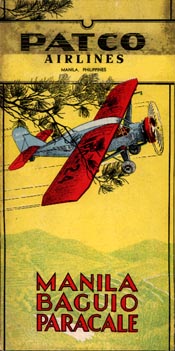 Since the Philippine Islands (PI) was a territory of the United States, the letter "N" was similarly adopted as prefix with the letter "P" as suffix, referring to the Philippine Islands. As the US FAA wanted separate codes for Puerto Rico, Marianas and the Philippines, it was assigned numbers instead of letters to appear as NP-XX. This was the marking of Philippine registered aircraft beginning 1906 to 1935.
Since the Philippine Islands (PI) was a territory of the United States, the letter "N" was similarly adopted as prefix with the letter "P" as suffix, referring to the Philippine Islands. As the US FAA wanted separate codes for Puerto Rico, Marianas and the Philippines, it was assigned numbers instead of letters to appear as NP-XX. This was the marking of Philippine registered aircraft beginning 1906 to 1935.A new code "PI" was however made effective before the war in 1941 after the 1912 convention was ratified by the United States, but no new plane was registered until after the war in 1946.
As there were more countries starting with an H, such as Haiti and Hungary, Netherlands identity was changed to H-N followed by three letters, referring still to Holland and Netherlands.
It so happen that the first airline in the world is KLM. The first two planes in the Dutch aviation register were KLM’s H-NABC and H-NABD (Fokker F.II).
Following the International Radiotelegraph Conference in Washington in 1927, the Dutch registration was changed again to PH.
So there begs the question. Why "P"?
As it turn out, Netherlands wanted to have letters assigned to its overseas territories in America, Africa and Asia similar to Great Britain. Having one two-letters prefix wouldn't be enough to accommodate all the radio stations within its territory. So the ITU assigned new prefix letters that were sequentially available. The letter was "P."
The Netherlands was assigned radio call signs for its overseas territories in the Caribbean, Africa and Dutch East Indies and attached to the new station consisting of five letters which had to begin with PA-PZ.
Because the aircraft radio stations in the Netherlands were split into various ministries, multiple registrations followed: PA for the Navy, PB for the Army (later the Air Force) and PH for civil aviation. Antilles in the Caribbean got PJ, while Indonesia got PK. Suriname on the other hand got PZ. As the letter in the alphabet was not enough to list Netherlands colonies, ITU added P1-P9, with Papua New Guenea listed at P2 while Aruba listed as P4.
The other series remained unused. The PH combination was adopted in preference to PE because the letter "H" (Holland) indicates its nationality, as with French (F), German (D) and Great Britain's (G).
PAL In PH Planes
Dutch authorities wanting to sell their Fokker planes gave Barretto a novel idea which reverberate to this day. Lease-to-own and code share deals. While PAL knew about code sharing it does not know yet leases to own.
The New Society and RP
The impact of decolonization and independence on aircraft registration schemes has varied results from country to country. But none was effected in the Philippines after it acquired independence from the United States in 1946.
Most countries have had a new allocation granted usually from the new country's new ITU allocation after independence. But neither is it uncommon for the new country to be allocated a subset of their former colonial power's allocation, as was the case of "NP-XX" and "NP-CXX" given by the Americans to their overseas colony.
However European countries already identified the Philippines as "Las Islas Filipinas" (The Philippine Islands) as early as 1903, which was fitting tribute to the "PI" code as was instilled in the 1912 Convention, had it been approved by America. But the United States at that time were notorious for not approving treaty obligation to the dismay of Europe. In fact, they were not a member of the League of Nations, a precursor to the United Nations, in the entirety of its existence.
When the Philippines finally got their independence in 1946, the PI prefix allocated by ITU and ICAN Conference, a precursor to ICAO, which has not been used at all, took effect and made effective in the Philippines.
The government of President Manuel Roxas never got the idea of "RP" prefix, meaning "Republic of the Philippines." The reason for that is because the "PI" prefix were never used. And the new Republic of the Philippines are more popularly known around the world as the " Philippine Islands." It also helped that most of the government's flying assets comprising mostly of DC-3 were handed over by the US to the Philippines bearing already the PI prefix sign.
And then President Ferdinand Marcos declared Martial Law in 1971 and instituted a change of government declaring a Fourth Philippine Republic in 1973 by the approval of the new Philippine Constitution replacing the ones made in 1935.
Consistent with the "New Republic" dubbed as Bagong Lipunan (New Society), the government changed the ICAO designation of the Philippines away from colonial identification in 1974 finally carrying the name of the Republic of the Philippines. The first aircraft to be registered under RP-C nationality markings was BAC1-11 (RP-C1184). It was retired from service in 1992 after flying exemplary flights.
The RP-C designation was not changed in 1987 following the approval of the 1987 Constitution and it has been that way ever since.
From N To RP Finally
Then, there was this separate orders for Airbus and Boeing planes also in 1977.
The US Eximbank maintained ownership over the aircraft until PAL decides to acquire it, thus the beginning of "N" registration again. It was followed by N742PR which arrive in February the following year and N743PR that arrived in March, while the last N744PR arrived in December 1980. None was acquired by PAL.
The CAAP
The change in registration concept began when CAAP Law came into being in 2008. It subsequently issued PCAR in June 2008 which was amended in 2011. PCAR requires all new aircraft to be registered in the Philippines while its foreign registration cancelled.
The new requirement came out after the painful experience of local authorities regarding foreign creditors during the 1998 Receivership hearing of Philippine Airlines, where foreign registered aircraft were out of reach of Securities and Exchange Commission (SEC) which handled the airline's rehabilitation, particularly referring to the Boeing B747s, and the Airbus fleets. It was Airbus consent that authorizes rehabilitation to proceed and consequently was approved in 1999. This was one reason why PAL ditch the Boeing B737s in favor of Airbus A319s and A320s, which they are still flying today.
So when the new triple seven ordered by Philippine Airlines in 2007 arrived in 2009, it was not marked as N777PR but RP-C7777. In the same manner, all new Airbus A320, A321, A330 and A350 fleet ordered by PAL was not marked anymore with French or German registration but was immediately registered with National markings of the Philippines.
CEB To Raise $500M For Survival
9 October 2020
Low cost carrier Cebu Pacific (CEB) has announced on Thursday that it will be raising up to $500 million in additional capital to provide fresh liquidity to the ailing airline by selling preferred shares and bonds in the stock market as it undertakes a restructuring strategy that seeks to cut its fleet and network to cope with reduced travel demand post covid19 pandemic.
“This capital raising exercise will provide the airline with the needed runway to withstand the financial challenges it faces as it slowly goes back to pre-Covid business levels and settles into the ‘new normal’,” says CEB Chief Executive Officer Lance Gokongwei.
CEB discloses that it will raise up to $250 million in new convertible preferred shares and another $250 million in private placement of convertible bonds subject to shareholder approval by November as it endeavors to strengthen the airline’s balance sheet.
The airline said it is was operating about 15% of pre-pandemic capacity, a far cry from their previous projections of 30%. Cebu Pacific started operating in June at about 2% capacity versus a normal 75%.
For the first six months of the year, Cebu Pacific reported a 61% year-on-year decline in revenue, at ₱ 17.3 billion ($357 million). It also reported an operating loss of ₱6.29 billion for the second quarter ending June 30, widening the ₱693 million loss incurred in 2020’s first quarter.
PH Carriers Received ₱20 Billion For Repatriation Flights
Read more at: https://www.bloombergquint.com/business/philippines-to-aid-troubled-airlines-but-won-t-want-to-own-them
Copyright © BloombergQuint
Another support package in Bayanihan 2 was ₱700 million loan assistance to domestic airlines guaranteed by the Government of the Philippines.
FEDEX Returns To The Philippines
Will Now Rely Less on Guangzhou Hub
8 October 2020
U.S.based courier Federal Express (FedEx) has announced its $30 million investment in the Philippines as it develops a new regional cargo terminal at Clark Air Base in Pampanga, as the U.S.-China trade war intensifies forcing the company to rely less on its Guangzhou hub.
The company said construction of the new and larger gateway, which began late last year, will be completed by first quarter of 2021 and will start operation in April 2021.
The two hectare facility will be expanded in phases, as it triple FedEx's sorting capability in the Philippines to 9,000 documents and parcels per hour initially. The facility will also have dedicated areas to process large heavyweight freight.
Fedex in a company statement said, the investment in Clark will bring the total number of team members to more than 800 workers surpassing FedEx's former facility at Subic Bay.
"This facility is the latest in a series of strategic investments that FedEx has made in the Philippines and across Asia-Pacific to enhance coverage and improve service levels in this important region," John Peterson, managing director at FedEx Philippines.
The Clark facility will house initially the company's expanded Philippine operations to service Covid19 vaccine delivery next year.
FedEx moved in 2009 its regional hub to Guangzhou from Subic, a former U.S. naval base turned industrial zone, which had served as its hub since 1995.
FedEx maintains however that it is keeping its Asia Pacific hub in Guangzhou for now.
“FedEx is not relocating and has no plans to relocate its Asia Pacific Hub, for now.” says Peterson.
“Our planned operations in Clark will enable us to better serve our customers in the Philippines and are part of our ongoing expansion throughout the Asia-Pacific region as our business continues to grow,” the company said.





